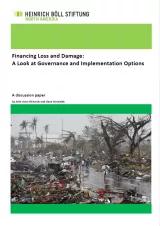Financing Loss and Damage: A Look at Governance and Implementation Options
In 2013 countries agreed to establish the Warsaw International Mechanism for Loss and Damage (WIM) and agreed that it would do three things: a) enhance knowledge; b) strengthen dialogue and coordination and c) enhance action and support, including finance for loss and damage. This third element of its mandate has been sorely neglected.
Almost no work has been done on how to fund loss and damage, how it fits with other streams of finance, and how loss and damage finance should be channeled to vulnerable countries. We are no closer now than we were in 2013 to vulnerable people and countries receiving loss and damage finance.
This report explores a number of elements that urgently need to be addressed: When it comes to implementation loss and damage overlaps with adaptation, humanitarian disaster recovery, disaster risk reduction, migration programs and so on. It’s important that loss and damage strategies and programmes are as impactful as possible for people on the ground. To avoid duplication and unnecessary complication, political and institutional coordination in these various areas will be needed.
When it comes to financing loss and damage activities, experience in adaptation finance shows that it will be useful to be clear what we mean by loss and damage. We review existing working definitions of loss and damage, and a range of illustrative examples, and isolate what makes loss and damage different to adaptation, disaster risk reduction, disaster response and development. As a result, we recommend the delineation of loss and damage by establishing a set of criteria, or guiding questions, as follows:
- Was the impact likely caused by, or made worse by, climate change?
- Does the impact require a significant change to traditional, or existing, livelihood, going beyond adjustments and instead require an altogether different order of magnitude reaction?
- Does it involve loss of something the community values and depends on?
Teamed with an illustrative, but not exhaustive, positive list that can be added to over time, as experience and understanding is deepened.
A proportion of an activity that meets the criteria of loss and damage should be able to qualify as loss and damage, whilst allowing a proportion of the project or activity to fit within other categories (eg: adaptation). Whilst country-driven, the determination as to whether loss and damage finance is justified should also be assessed by a WIM authorized panel.
This discussion paper, while not presenting the final word on a range of issues related to international loss and damage financing, has nevertheless outlined some concrete steps forward over the next two years. Further analysis and discussion is clearly needed, and we welcome future contributions and comments.
Product details
Table of contents
- Executive Summary
- Introduction
- Mandate to deal with loss and damage finance
- What is loss and damage? How is it different to adaptation, humanitarian aid, disaster risk reduction, disaster response, and resilience?
- Scale of need versus available funding
- Potential sources of loss and damage finance
- Global Climate Finance Architecture
- What should the institutional structure for loss and damage finance be?
- Relevant other issues in need of further exploration
- Next steps: Political process and implementation time line
